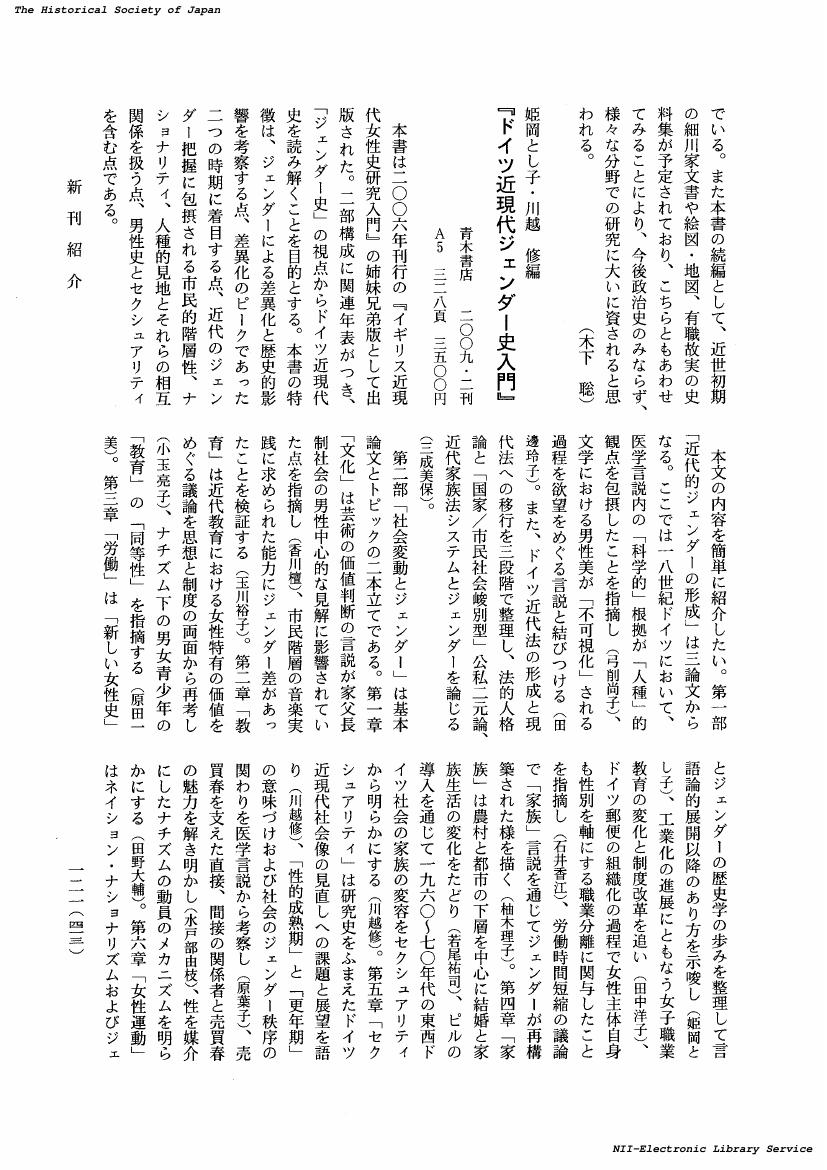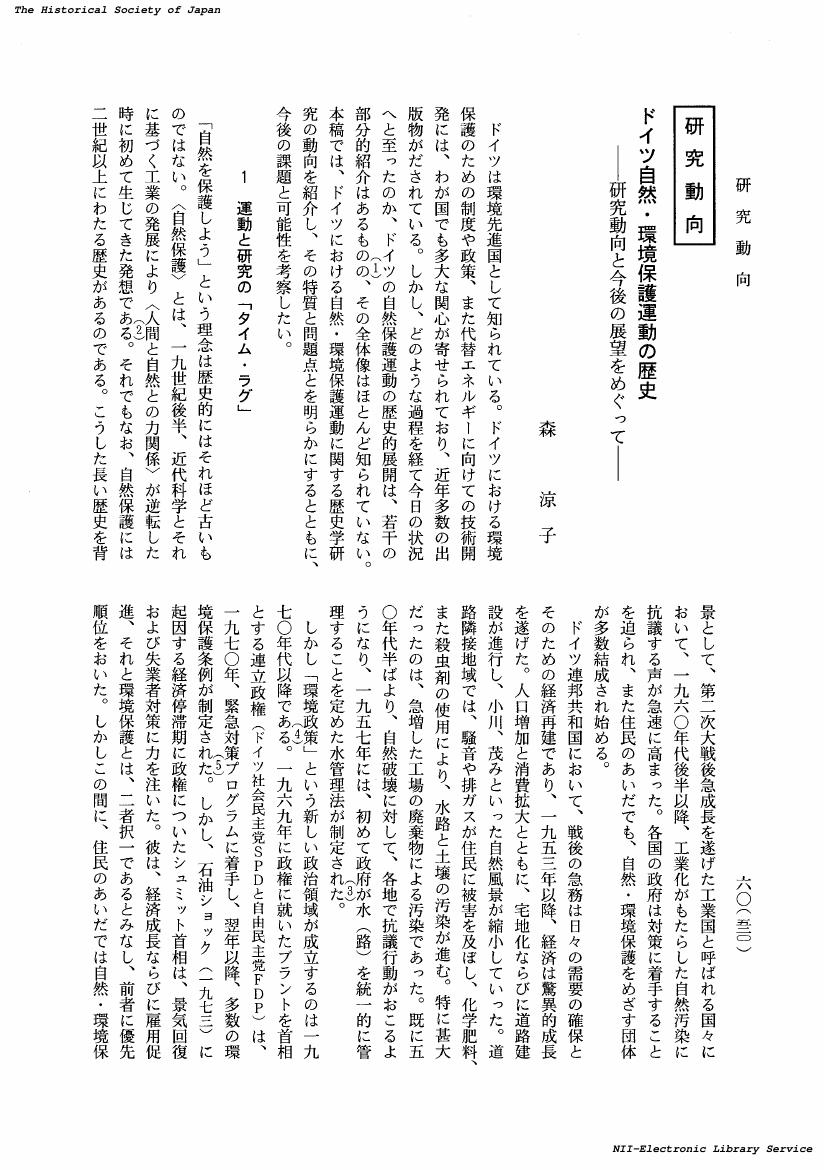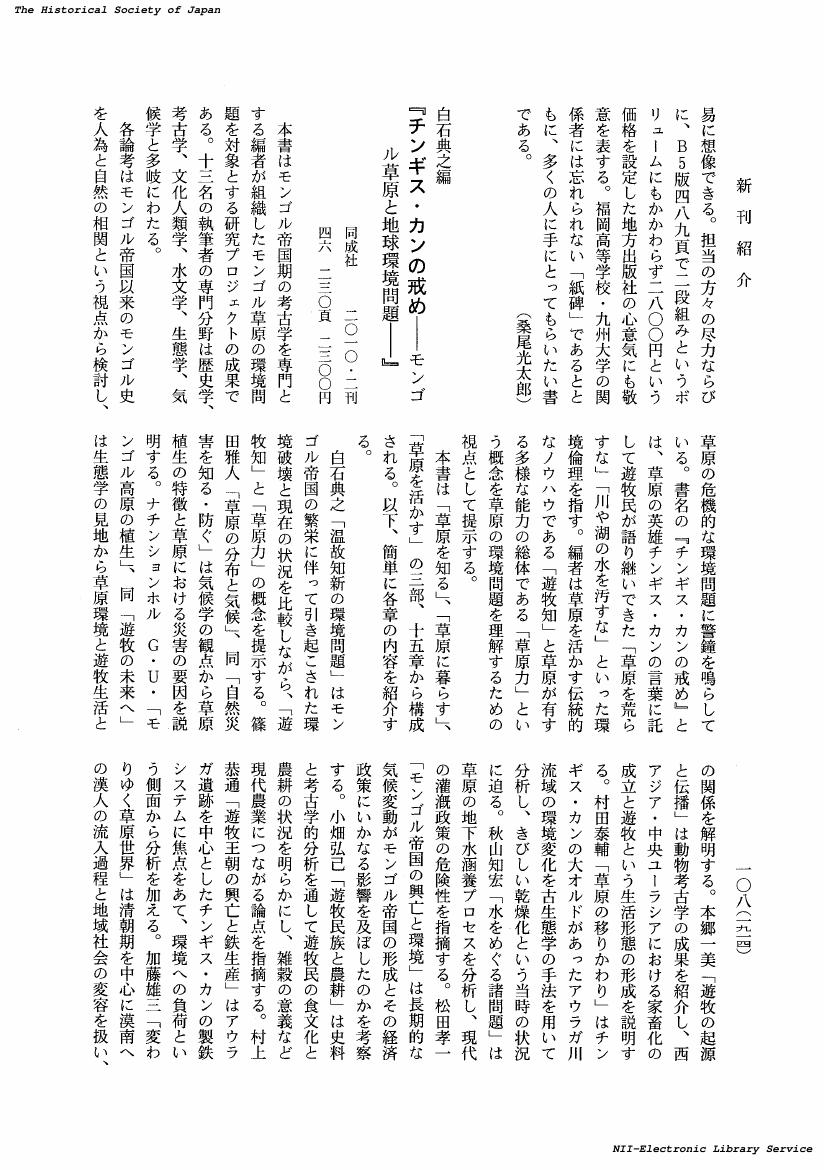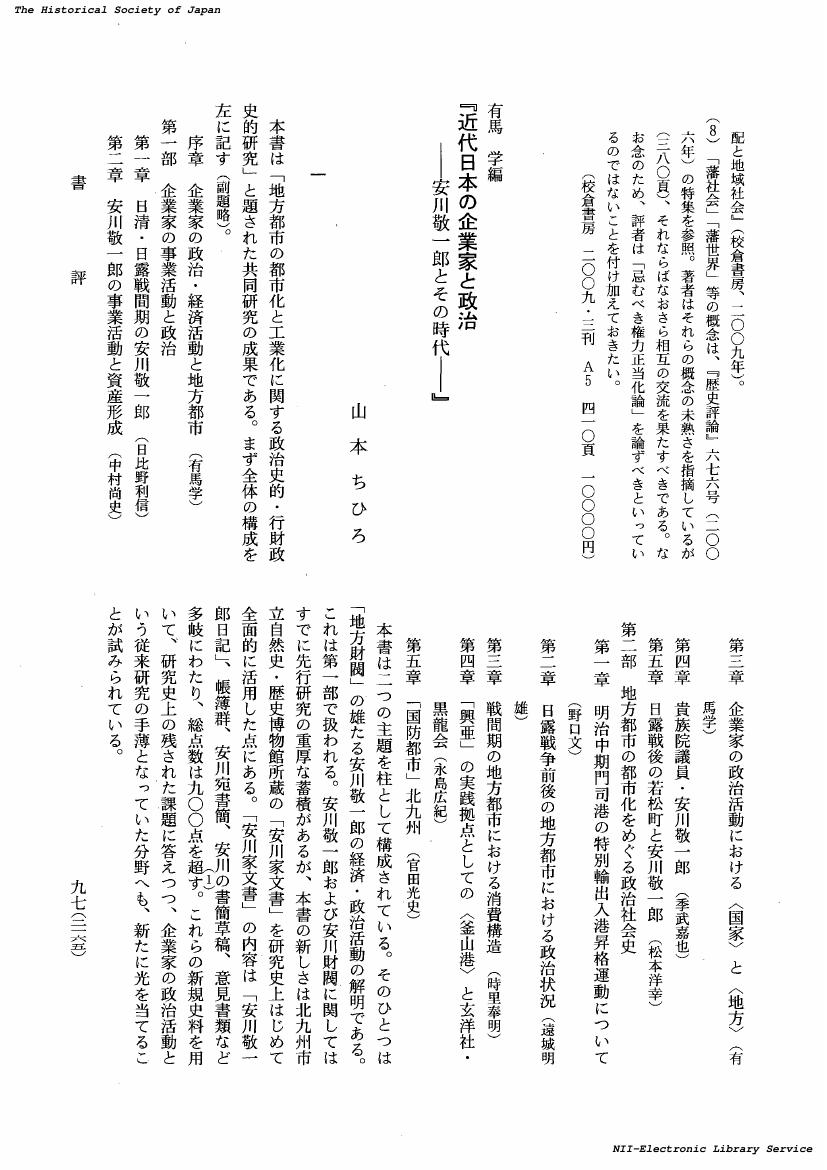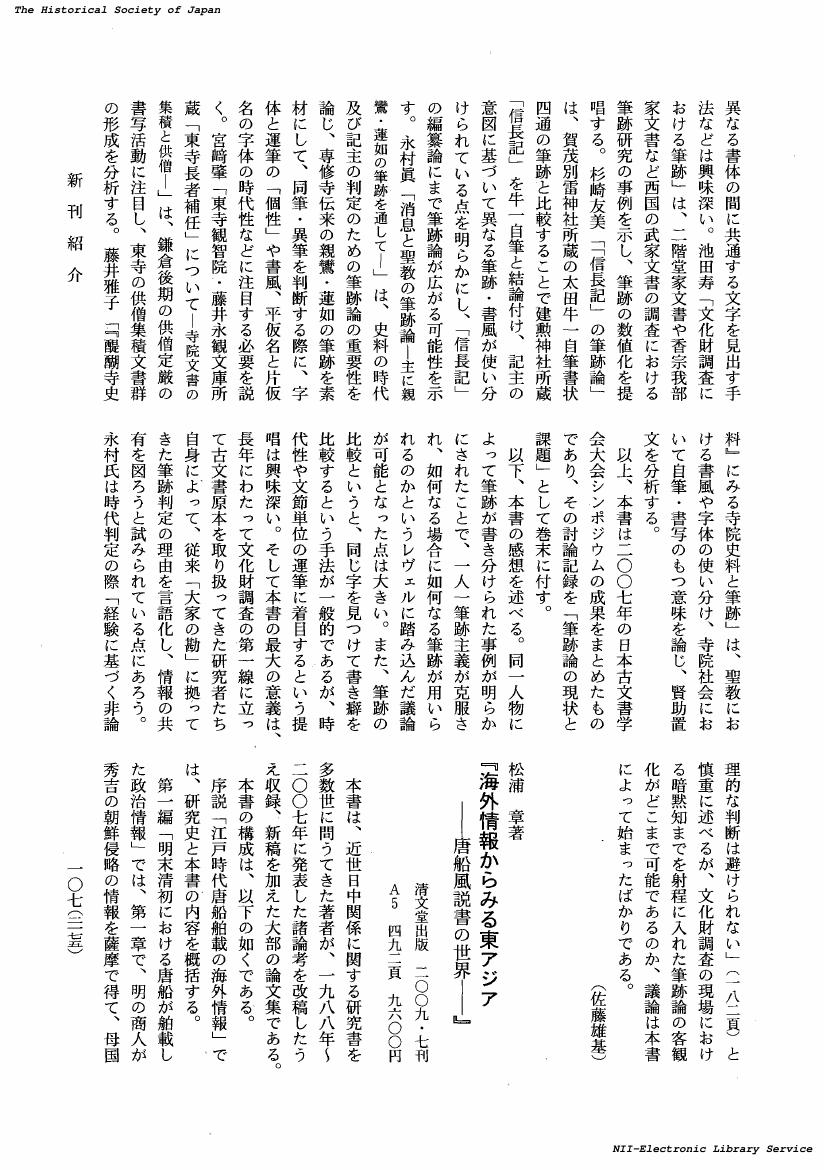- 著者
- 山田 欣吾
- 出版者
- 公益財団法人 史学会
- 雑誌
- 史学雑誌 (ISSN:00182478)
- 巻号頁・発行日
- vol.123, no.6, pp.1199-1208, 2014-06-20 (Released:2017-07-31)
- 著者
- 小野寺 拓也
- 出版者
- 公益財団法人 史学会
- 雑誌
- 史学雑誌 (ISSN:00182478)
- 巻号頁・発行日
- vol.123, no.7, pp.1401, 2014-07-20 (Released:2017-07-31)
- 著者
- 吉井 文美
- 出版者
- 公益財団法人 史学会
- 雑誌
- 史学雑誌 (ISSN:00182478)
- 巻号頁・発行日
- vol.122, no.8, pp.1456-1457, 2013-08-20 (Released:2017-12-01)
- 著者
- 長沼 秀幸
- 出版者
- 公益財団法人 史学会
- 雑誌
- 史学雑誌 (ISSN:00182478)
- 巻号頁・発行日
- vol.122, no.4, pp.569-570, 2013-04-20 (Released:2017-12-01)
1 0 0 0 OA モンゴル合戦の恩賞配分と充行状
- 著者
- 高 銀美
- 出版者
- 公益財団法人 史学会
- 雑誌
- 史学雑誌 (ISSN:00182478)
- 巻号頁・発行日
- vol.121, no.1, pp.43-67, 2012-01-20 (Released:2017-12-01)
The Mongols invaded Japan in 1274 and 1281, both times unsuccessfully. With regard to the subject of rewards distributed among warriors who fought against the invasions, the research to date has been based on analyzing documents (ateokonaijo 充行状) certifying that payments were made to individual warriors. Consequently, we generally know when a reward was given to whom; however, further study is required in order to discover out whether rewards were paid to all the warriors who fought, and if so, when the payment process was completed. This is the reason behind the possibility that the payment process may not have been completely over immediately after the invasions. This article attempts to clarify when the distribution was completed, based on the documents left by warriors who raised objections after being excluded from payment. It also traces changes that occurred in the form of the ateokonaijo that were issued after the second Mongol invasion and their significance. After the first Mongol invasion of 1274, investigations were conducted to find those warriors who showed great valor and was completed in the 12th month of the same year. The rewards granted as a result were paid no later than the 3rd month of the year after next. In the case of the second invasion of 1281, a similar investigation was carried out from 1281 to 1286, and the warriors who were acknowledged for their service received rewards over four occasions between 1286 and 1290. However, a number of warriors who were not so acknowledged filed a petition for reinvestigation, and a review was held. Consequently, the Kamakura Shogunate made a promise to provide another round of rewards to the newly acknowledged recipients. It can be confirmed that the promise was fulfilled later on. In other words, the reward process for military service in the defensive action against the Mongols was in fact completed, and the Kamakura Shogunate did not abandon its basic principle of providing compensation to its vassals who fought. In addition, on the basis of changes that took place in the form of ateokonaijo, the Mongol invasions seem to have served as an opportunity for the HOTO clan of regents who controlled the Kamakura Shogunate to strengthen its absolute authority within the institution. The fact that different forms of ateokonaijo were issued in order to distinguish vassals charged with the military policing of provinces (shugo 守護) and other vassals indicates that Shogunate vassals were beginning to be treated unequally.
- 著者
- 中込 さやか
- 出版者
- 公益財団法人 史学会
- 雑誌
- 史学雑誌 (ISSN:00182478)
- 巻号頁・発行日
- vol.120, no.3, pp.413-414, 2011-03-20 (Released:2017-12-01)
1 0 0 0 OA 戦時社会主義と「初期現代文明」ドイツの出現 : 第一次世界大戦と近代の終焉
- 著者
- 鍋谷 郁太郎
- 出版者
- 公益財団法人 史学会
- 雑誌
- 史学雑誌 (ISSN:00182478)
- 巻号頁・発行日
- vol.120, no.3, pp.358-385, 2011-03-20 (Released:2017-12-01)
During World War I, a phenomenon that diverged greatly from the framework of the 19〜<th> century "Pax Britannica" world, which has been termed by historian Ishii Norie as the "early contemporary syndrome," emerged in earnest among the European countries embroiled in total war. This phenomenon included such aspects as the advent of mass democracy, monopoly capitalism (or at least state economic control relative to the advancement of monopoly capitalism), and a social welfare system, anticipating 20th century state intervention in solving social issues. It was in Germany where this "syndrome" emerged most sharply, and also in Germany where Marxian theorists affiliated with the Social Democratic Party of Germany (SPD) attempted to study the "syndrome" most systematically and explore its historical significance. This article, which focuses on Paul Lensch, the architect of a conceptual system called "wartime socialism" that placed World War I in the positive context of a socialist world revolution, is an attempt to trace once again his ideological struggle with the "early contemporary syndrome" during the War. Although Lensch was known before the War as a leftist theorist rivaling the likes of Rosa Luxemburg, as the conflict progressed, he changed his stance and supported it. However, Lensch's turn-around proves to be not as simple as the "about-face to social exclusionism" described by Lenin. Rather, Lensch continued his efforts to discover the historical meaning of the War and clearly postulate the "end of the modern era" from the standpoint of socialism.
1 0 0 0 OA ドイツ近代の名誉市民権 : その起源と意義
- 著者
- 森田 直子
- 出版者
- 公益財団法人 史学会
- 雑誌
- 史学雑誌 (ISSN:00182478)
- 巻号頁・発行日
- vol.120, no.11, pp.1833-1856, 2011-11-20 (Released:2017-12-01)
The honorary citizenship (Ehrenburgerrecht) bestowed by the German towns has been considered to be comparable with such honours as the orders, titles and prizes conferred by the state or the monarch from the mid-nineteenth century on. Also, the research done on a Prussian metropolis during the German empire tells us that honorary citizenship was highly reputed and played a significant role in the political culture of the city. But when did this custom first appear? And why did honorary citizenship(=civic right) possess such value? In an attempt to answer these questions, this article examines 1) the concept of honorary citizen or citizenship, 2) several historical cases in which towns provided certain people with civic right (Burgerrecht) out of gratitude or affection without obligation, 3) "le titre de citoyen francais" bestowed by revolutionary France on foreigners with great accomplishments, and 4) the codification of honorary citizenship in modern municipal laws beginning with the Prussian "Stein's municipal law" of 1808. The author concludes that the concept of honorary citizen (ship) has been characterised by the ideas of the German medieval township and its civic right, and that the regulations pertaining to honorary citizenship in the municipal laws were also interrelated with the recognition of traditional citizenship. As to the origin of modern honorary citizenship, it was based on the image of an idealised medieval version, established under the influence of the French Revolution and then institutionalised in municipal laws during the nineteenth century. Furthermore, the high reputation attributed to honorary citizenship was rooted in the traditional value of the kind of idealized medieval township reflected in civic right.
1 0 0 0 OA ドイツ自然・環境保護運動の歴史 : 研究動向と今後の展望をめぐって(研究動向)
- 著者
- 森 涼子
- 出版者
- 公益財団法人 史学会
- 雑誌
- 史学雑誌 (ISSN:00182478)
- 巻号頁・発行日
- vol.120, no.4, pp.520-545, 2011-04-20 (Released:2017-12-01)
- 著者
- 芦部 彰
- 出版者
- 公益財団法人 史学会
- 雑誌
- 史学雑誌 (ISSN:00182478)
- 巻号頁・発行日
- vol.121, no.1, pp.126, 2012-01-20 (Released:2017-12-01)
1 0 0 0 OA 日露戦争前後における中東鉄道収用地の形成と植民計画 : 満洲における特殊法域の誕生
- 著者
- 麻田 雅文
- 出版者
- 公益財団法人 史学会
- 雑誌
- 史学雑誌 (ISSN:00182478)
- 巻号頁・発行日
- vol.119, no.9, pp.1493-1524, 2010-09-20 (Released:2017-12-01)
The Chinese Eastern Railway (hereafter, CER), a useful shortcut for the Trans-Siberian Railway, was built by the Russian Empire under a contract concluded with the Qing Dynasty in 1896; and the resulting railway zone was administered solely by the Russians until 1917. Although the Russian community in the railway zone has been a popular topic of discussion among scholars in Japan, the U.S., Russia, and China, little is known about the railway zone itself, which comprised the legal and institutional structure of this "colony." The aim of this article is to clarify how the railway zone was formed, from the standpoints of both Russia and China. The article begins with an analysis of how the CER appropriated land. In the beginning, the scale of appropriation was limited to the immediate needs of railway construction ; later, however, S. Iu. Witte, the Russian finance minister and supervisor of the CER, instructed the railway engineers to expand appropriation to the greatest extent possible. In Harbin alone, which was the base of construction and the junction of the railway lines with the Songhua River, 11,533 hectares had been appropriated by 1902. The author argues that the reason for this was that Witte wanted the CER to sell or lease the land as a developer, in order to recover the cost of railway construction. The expansion of the railway zone was a concern for the Qing Dynasty's military governors in Manchuria, because such an expansion implied an increase in Russian influence within the Dynasty's homeland. Therefore, the governors made prompt attempts to Sinicize the area around the railway zone by means of colonies populated by Han settlers. The Russian Empire felt a sense of crisis in response to this movement and planned to settle Russian colonists within the railway zone. Eventually, the Qing Dynasty realized a significant increase in the Han population of Manchuria, while Russia's colonization plans did not materialize, owing to 1) a conflict of opinion among government ministries and 2) the outbreak of the Russo-Japanese War. Despite its failure to realize a large-scale colonization project, Russian still managed to maintain extensive executive powers in the governance of the railway zone. The CER played the role of administrative organ and monitored both judicial affairs and the policing of the zone. It was in this way that Russia attempted to Russify the area. The railway zone was undeniably a part of Russia's informal empire ; however, China constantly sought opportunities to recapture sovereignty over the area. The railway zone would survive until the Manzhouguo government abolished it in 1936.
- 著者
- 麻田 雅文
- 出版者
- 公益財団法人 史学会
- 雑誌
- 史学雑誌 (ISSN:00182478)
- 巻号頁・発行日
- vol.120, no.1, pp.108, 2011-01-20 (Released:2017-12-01)
1 0 0 0 OA ボドー事件と外モンゴルの政治情勢
- 著者
- 青木 雅浩
- 出版者
- 公益財団法人 史学会
- 雑誌
- 史学雑誌 (ISSN:00182478)
- 巻号頁・発行日
- vol.119, no.3, pp.293-324, 2010-03-20 (Released:2017-12-01)
After resigning as prime minister and foreign minister of the Mongolian People's Government in January 1922, Bodoo, an important leader of the Mongolian People's Party, was purged in the following summer, giving rise to what is called the "Bodoo Affair." After the Mongolian People's Government was formed, Soviet Russia and the Comintern become very important factors determining the political situation in Outer Mongolia; however, the research to date has yet to study the influence exerted by the Bodoo Affair on their strategy. The purpose of this article is to analyze that influence in order to further illuminate the facts surrounding the Affair, the political situation in Outer Mongolia and one aspect of the process in which Soviet Russia expanded its sphere of influence in East Asia. In the beginning, Soviet Russia and the Comintern placed Bodoo in high regard as a politician well suited to their purposes. However, Bodoo himself regarded these two powers as interfering in Outer Mongolia and became opposed to A. Ya. Okhtin, the vice-representative of Soviet People's Commissariat for Foreign Affairs in Outer Mongolia. This is why Bodoo left the Mongolian People's Government and along with his comrades tried to pursue ways of developing Outer Mongolia without Soviet assistance. At that time in Outer Mongolia, there were many people who stood against Soviet Russia and the Mongolian People's Government, and Okhtin was well aware of these "anti-Soviet elements." In response, he planned to bring in more Soviet staff members to build the Mongolian People's Party with Soviet Russia's direct participation and form new Party lines suited to the present condition. In practice, however, the new Government included such "anti-Soviet elements" as the Mongolian aristocracy and Buddhist sects in order to stabilize the situation. The article concludes that Soviet Russia and the Comintern were to forced change their former strategy of regarding Outer Mongolia as an "ally" in the face of the Bodoo Affair, which presented an obstacle to their plan to utilize Outer Mongolia in the interest of their national security in the Far East. The Affair brought about changes not only in the formation of the Mongolian People's Government, but also in Soviet Russia's Mongolian policy, thus representing an important turning point in Mongolia's modern history.
- 著者
- 植田 暁
- 出版者
- 公益財団法人 史学会
- 雑誌
- 史学雑誌 (ISSN:00182478)
- 巻号頁・発行日
- vol.119, no.11, pp.1914-1915, 2010-11-20 (Released:2017-12-01)
- 著者
- 鍋谷 郁太郎
- 出版者
- 公益財団法人 史学会
- 雑誌
- 史学雑誌 (ISSN:00182478)
- 巻号頁・発行日
- vol.119, no.1, pp.121, 2010-01-20 (Released:2017-12-01)
- 著者
- 森田 直子
- 出版者
- 公益財団法人 史学会
- 雑誌
- 史学雑誌 (ISSN:00182478)
- 巻号頁・発行日
- vol.119, no.1, pp.120, 2010-01-20 (Released:2017-12-01)
- 著者
- 鈴木 楠緒子
- 出版者
- 公益財団法人 史学会
- 雑誌
- 史学雑誌 (ISSN:00182478)
- 巻号頁・発行日
- vol.118, no.1, pp.135, 2009-01-20 (Released:2017-12-01)
- 著者
- 山本 ちひろ
- 出版者
- 公益財団法人 史学会
- 雑誌
- 史学雑誌 (ISSN:00182478)
- 巻号頁・発行日
- vol.118, no.12, pp.2165-2173, 2009-12-20 (Released:2017-12-01)
- 著者
- 佐藤 雄基
- 出版者
- 公益財団法人 史学会
- 雑誌
- 史学雑誌 (ISSN:00182478)
- 巻号頁・発行日
- vol.118, no.12, pp.2174-2175, 2009-12-20 (Released:2017-12-01)
- 著者
- 松方 冬子
- 出版者
- 公益財団法人 史学会
- 雑誌
- 史学雑誌 (ISSN:00182478)
- 巻号頁・発行日
- vol.118, no.12, pp.2175-2177, 2009-12-20 (Released:2017-12-01)




